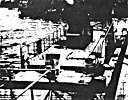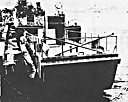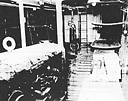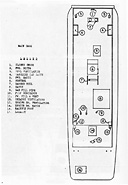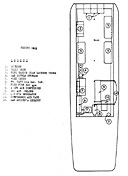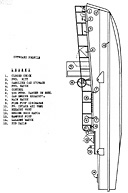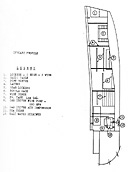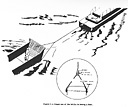| Stock No. |
DESCRIPTION |
Unit |
Quantity |
| 41B282 |
Bar, Pinch, 7/8" dia. |
No. |
1 |
| 41C1052 |
Chisel Cape, 1/4" |
No. |
1 |
| 41C1114 |
Chisel Cold, 5/8" |
No. |
1 |
| 41C1138 |
Chisel, Cold 1" |
No. |
1 |
| 41C1235 |
Chisel, Cold 1/4" |
No. |
1 |
| 41C1660 |
Clamps "C", 41/2" |
No. |
4 |
| 41C1691 |
Soldering iron, electric, med. |
No. |
1 |
| 41O1663 |
Drill, breast, 1/8" to 1/2" |
No. |
1 |
| 40D345 |
Drill, Electric, Portable, 1/2" |
No. |
1 |
| 41F863 |
Files, 12" flat bastard |
No. |
1 |
| 41F933 |
File, 12" half round, bastard |
No. |
1 |
| 41F952 |
File, 8" half round smooth |
No. |
1 |
| 41F955 |
File, 12" half round smooth |
No. |
1 |
| 41F1307 |
File, 12" round bastard |
No. |
1 |
| 41F1302 |
File, 6" round bastard |
No. |
1 |
| 41F1365 |
File, 10" square bastard |
No. |
1 |
| 41G40 |
Thickness gage |
No. |
1 |
| 41H338 |
Hammer, Hand, 21/2" double face |
No. |
1 |
| 41H525 |
Hammer, Ball Pein, 24 oz. |
No. |
1 |
| 41H187 |
Hammer, Claw type D |
No. |
1 |
| 41H2101 |
Hoist, Chain, 1/2 ton |
No. |
1 |
| 1301535 |
Oil Can |
No. |
2 |
| 41P1631 |
Pliers, 6" slip joint |
No. |
1 |
| 41P1635 |
Pliers, 10" slip joint |
No. |
1 |
| 41P1977 |
Pliers, 7" side cut 6" |
No. |
1 |
| 41P3185 |
Punches, Center |
No. |
2 |
| 41R2844 |
Rules, folding, 6' |
No. |
2 |
| 41F3390 |
Saws, Hack, Frame-Minus 2 handles |
No. |
1 |
| 41B1155 |
Blades, Hack Saw 12" -- 18 tooth |
Dz. |
2 |
| 41B1167 |
Blades, Hack Saw 12" -- 32 tooth |
Dz. |
2 |
| 41S188 |
Saw, Hand, Cross Cut, 26" |
No. |
1 |
| 41S1104 |
Screw Driver, 6" |
No. |
1 |
| 41S1110 |
Screw Driver, 12" |
No. |
1 |
| 41S1116 |
Shears, tin |
No. |
1 |
| 41W114 |
Wedges, 4" x 11/2" |
No. |
2 |
| 41W597 |
Wrench, double end, box, 12 pt. 5/16 x 3/8 |
No. |
1 |
| 41W599 |
Wrench, double end, box, 12 pt. 7/16 x 1/2 |
No. |
1 |
| 41W601 |
Wrench, double end, box, 12 pt. 9/16 x 5/8 |
No. |
1 |
| 41W605 |
Wrench, double end, box, 12 pt. 13/16 x 7/8 |
No. |
1 |
| 41W608 |
Wrench, double end, box, 12 pt. 16/16 x 1 |
No. |
1 |
| 41W610 |
Wrench, double end, box, 12 pt. 1-1/16 x 1-1/8 |
No. |
1 |
| 41W612 |
Wrench, double end, box, 12 pt. 11/4 x 1-15/16 |
No. |
1 |
| 41W910 |
Wrench, open end, 7/16 x 1/2 |
No. |
1 |
| 41W915 |
Wrench, open end, 9/16 x 5/8 |
No. |
1 |
| 41W920 |
Wrench, open end 3/4 x 13/16 |
No. |
1 |
| 41W925 |
Wrench, open end, 7/8 x 15/16 |
No. |
1 |

 ] by day as a
means of identification and will keep the Traffic Control Boat
and Beachmaster informed of his location during the night by
screened signal apparatus.
] by day as a
means of identification and will keep the Traffic Control Boat
and Beachmaster informed of his location during the night by
screened signal apparatus.
